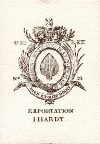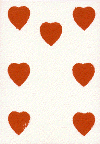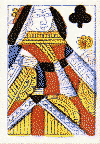Great Mogul
I. Hardy, Cardmaker to His Majesty and the Prince of Wales
![[Tax Stamp]](hardyba2.gif)
![[Wrapper]](hardybb2.gif) I
originally saw this deck advertised as period cards in an American Civil
War (1861-1865) catalog. I admit I have very little substantial knowledge
about cards in that period, but my gut feeling is that these cards are
from at least a century beforehand. Like the I. Kirk,
"Aesop's Fables" deck, this deck is simple, square-cut, and
without decoration on the back. It is, in presentation, almost identical
to the Kirk cards, which leads me to the conclusion that they're made by
the same company. Just what company that is, I haven't yet discovered.
I
originally saw this deck advertised as period cards in an American Civil
War (1861-1865) catalog. I admit I have very little substantial knowledge
about cards in that period, but my gut feeling is that these cards are
from at least a century beforehand. Like the I. Kirk,
"Aesop's Fables" deck, this deck is simple, square-cut, and
without decoration on the back. It is, in presentation, almost identical
to the Kirk cards, which leads me to the conclusion that they're made by
the same company. Just what company that is, I haven't yet discovered.
Shown here at left is the tax stamp, an embossed (you can't quite make
out the embossing - a limit of my scanner, I suppose) seal of paper wrapped
around the deck which showed that the taxes on the pack had been paid.
Also not visible here is the amount - 16 pence. There is a whole branch
of philately dedicated to tax stamps, including playing card stamps, which
I know very little about. More information on tax
stamps can be found in the materials listed in the playing-cards
mailing list FAQ. I admit I've never seen a real deck of cards from
this period, but I imagine that this is an accurate depiction of what a
deck would look like.
At right is the other side of the unopened deck. You can see the tax
stamp peeking around the edges (and indeed tied there with a string), and
underneath, the real wrapper of the deck showing the maker's stamp, and
the name of the deck. I've yet to see a relationship between the name and
the designs in the deck, but perhaps it's as meaningful as the names of
modern automobiles, which is to say not at all. On the side, which you
can't see in these pictures, is the warning of severe legal repercussions
to be visited on somebody who relands the cards in Britain. Presumably
the taxes paid were specifically geared towards the destination port, and
the deck might cost very differently in Britain and in the Colonies. All
over the deck can be found the requirement that the deck is for Export
Only. Note the ace of spades below.
The deck itself is printed on uncoated heavy card stock, cut with square
corners, and has no design on the back, which is what, I understand, real-people's
cards were like until the 19th and 20th centuries. Coating, of course,
wouldn't have existed as we know it at all until very recently, and back
designs were an expensive and useless luxury (and an invitation to marking).
The deck is a simple, standard set of number- and face-cards, presumably
designed for common use. You can see that the printing is done in four
colors: red, blue, yellow and black. And likewise, that the colors were
printed separately, one atop the other. That's consistent with the normal
techniques for doing multi-color wood-cut printing, where either you would
make four sets of plates, or mask your master plates for each color. My
guess would be that these were done (at least originally) with multiple
plates, but I might just be making this up as I go along. All images are
the property of the copyright holder, and are provided here only for scholarly
analysis.
|
Ace of Spades

|
Seven of Hearts

|
|
The Jack of Diamonds

|
Queen of Clubs

|
Return to cards page
Send me mail.
![[Tax Stamp]](hardyba2.gif)
![[Wrapper]](hardybb2.gif) I
originally saw this deck advertised as period cards in an American Civil
War (1861-1865) catalog. I admit I have very little substantial knowledge
about cards in that period, but my gut feeling is that these cards are
from at least a century beforehand. Like the I. Kirk,
"Aesop's Fables" deck, this deck is simple, square-cut, and
without decoration on the back. It is, in presentation, almost identical
to the Kirk cards, which leads me to the conclusion that they're made by
the same company. Just what company that is, I haven't yet discovered.
I
originally saw this deck advertised as period cards in an American Civil
War (1861-1865) catalog. I admit I have very little substantial knowledge
about cards in that period, but my gut feeling is that these cards are
from at least a century beforehand. Like the I. Kirk,
"Aesop's Fables" deck, this deck is simple, square-cut, and
without decoration on the back. It is, in presentation, almost identical
to the Kirk cards, which leads me to the conclusion that they're made by
the same company. Just what company that is, I haven't yet discovered.


